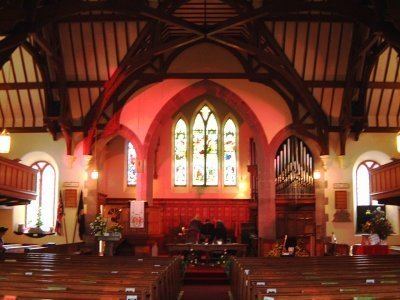Parish Dunnottar Church | Churchmanship Reformed Minister(s) Rev Rosslyn Duncan | |
 | ||
Presbytery Presbytery of Kincardine and Deeside Similar | ||
Exterior dunnottar parish church stonehaven scotland
Dunnottar Parish Church is a parish church of the Church of Scotland, serving Stonehaven in the south of Aberdeenshire, Scotland. It is within the Church of Scotland's Presbytery of Kincardine and Deeside.
Contents
- Exterior dunnottar parish church stonehaven scotland
- Dunnottar parish church kirkyard stonehaven scotland
- Location
- History of the Parish of Dunnottar
- Buildings
- References
Dunnottar parish church kirkyard stonehaven scotland
Location
The church building is situated in Dunnottar woods, Stonehaven (within the AB39 postcode area), sitting high above the bank on the Carron water. It sits on the south-western periphery of Stonehaven, and is approximately a 20-minute walk from the Market Square in the centre of town. Dunnottar Castle stands approximately one and a half miles to the south-east of the church. The manse stands directly across the road to the west.
Dunnottar Parish also holds property including St Bridget's hall on Dunnottar Avenue, Stonehaven. The hall, which was built in 1887 and stands on the site of a previous church, was built to act as a missionary church to the Old Town, or 'Auld Toon', of Stonehaven. Historically morning services were held in Dunnottar Church, and evening services were held in St Bridget's. St Bridget's hall is now used for the Parish Evening Communion and meeting of the Church's organisations. It is also let out to community organisations.
History of the Parish of Dunnottar
Dunnottar Church was consecrated in 1394 in place of the original church dedicated to Saint Ninian, the 'Apostle of the Picts', which still stands on Dunnottar Castle rock. This earlier church was consecrated in 1276 by William Wishart, the Bishop of St Andrews.
One feature of the churchyard is the presence of the Covenanters Stone, a reminder of the Covenanters who were imprisoned in nearby Dunnottar Castle. This stone is said to have been the inspiration for Sir Walter Scott in his novel 'Old Mortality', whereby he watched Robert Patterson carefully and lovingly restore the lettering on the Covenanters Stone.
Buildings
The church, in its present location, was re-built in 1852 and later extended in 1869. It again underwent major reconstruction in 1903, which made it considerably larger when a nave and chancel were added, turning the previously rectangular building into a cruciform shape. The building recently underwent more renovations, this time to make it more accessible, and to include a multi-purpose activity room.
The churchbell which was cast in 1793 by Andrew Lawson, the last of the Old Aberdeen founders is supposed to be one of the best examples of his work, F. C. Eeles in his “Church bells of Kincardineshire” speaks of it as follows:
“Insignificant though they are, those few fleur-de-lys used on the Dunnottar bell are perhaps one of the very latest survivals of the ecclesiastical art of the Middle Ages. This is perfectly possible because founders' stamps were handed on from one founder to another and in England there are several cases of the use of medieval stamps at the end of the 17th century. Moreover, in the foreign mouldings and outline of the Dunnottar bell, we see a lingering survival of that continental influence which ever since the English wars in the 14th century had held such sway in Scotland.”
The Marischal Aisle (nowadays a Mausoleum), sits in the current church grounds and was first build in 1582 by George Keith, the 5th Earl Marischal of Scotland and founder of Marischal College in Aberdeen.
